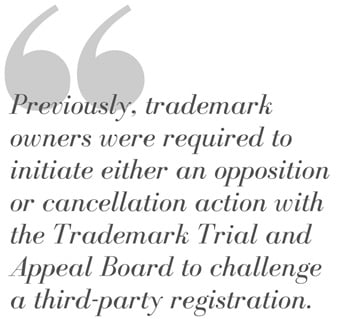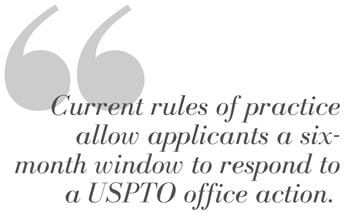Trademark Modernization Act—What New and Upcoming Changes Could Mean for Your Trademarks
DOWNLOAD PDF- Norton, Shauna L.
- Industry Alerts
Click “Subscribe Now” to get attorney insights on the latest developments in a range of services and industries.
The Trademark Modernization Act (“TMA”) was signed into law on December 27, 2020. Among other things, the TMA created new procedures for challenging pending applications and registrations and updated several rules relating to the prosecution of trademark applications before the United States Patent and Trademark Office (“USPTO”). Several of these changes took effect in December 2021, while other changes will be implemented later this year.
Below are the most notable changes made by the TMA and key takeaways for trademark practitioners and brand owners.
New Procedures for Challenging Registered Trademarks and Pending Applications
To address the rise in fraudulent trademark filings for marks that are not actually used in United States commerce, and to help clear the registry of unused trademarks, the TMA instituted two new ex parte procedures that trademark owners can utilize to challenge such marks – an expungement proceeding and a reexamination proceeding. Previously, trademark owners were required to initiate either an opposition or cancellation action with the Trademark Trial and Appeal Board (the “TTAB”) to challenge a third-party registration. However, because TTAB proceedings can be both time-consuming and expensive, these new procedures offer trademark owners a faster, more cost-efficient option to help clear the path for registering their trademarks. The TMA also added a new ground to bring a cancellation action before the TTAB and formalized the procedures for Letters of Protest. These changes, summarized below, are now in effect.
 Expungement Proceeding – A third party or the Director of Trademarks may seek expungement of a trademark registration based on evidence that the registered mark has never been used in commerce in connection with some or all of the goods/services listed in the registration. Petitions for expungement can only be filed between 3 and 10 years after the date of registration, except that until December 27, 2023, any registration that is at least three years old may be subject to expungement, regardless of the 10-year limit. A petition for expungement must be accompanied by the required fee ($400 per class), a concise statement of relevant facts, along with a verified statement that a reasonable investigation was completed regarding use of the challenged mark, signed by someone with first-hand knowledge, and supporting evidence. If the USPTO determines that the petition presents a prima facie case of nonuse, the USPTO will institute the proceeding, after which the registrant will be provided with notice and an opportunity to respond.
Expungement Proceeding – A third party or the Director of Trademarks may seek expungement of a trademark registration based on evidence that the registered mark has never been used in commerce in connection with some or all of the goods/services listed in the registration. Petitions for expungement can only be filed between 3 and 10 years after the date of registration, except that until December 27, 2023, any registration that is at least three years old may be subject to expungement, regardless of the 10-year limit. A petition for expungement must be accompanied by the required fee ($400 per class), a concise statement of relevant facts, along with a verified statement that a reasonable investigation was completed regarding use of the challenged mark, signed by someone with first-hand knowledge, and supporting evidence. If the USPTO determines that the petition presents a prima facie case of nonuse, the USPTO will institute the proceeding, after which the registrant will be provided with notice and an opportunity to respond.
Reexamination Proceeding – A third party or the Director of the USPTO may institute a reexamination proceeding to challenge a registration based on evidence that the mark was not in use in commerce in connection with some or all of the goods/services as of the filing date of the application, amendment to allege use, or before the filing deadline for a statement of use. A reexamination proceeding must be filed within the first five years of registration. Again, before the proceeding is instituted, the USPTO will determine whether the petitioner has made a prima facie case of nonuse. If the petition has established a prima facie case of nonuse, the USPTO will provide notice to the registrant and an opportunity to respond.
New Ground for Cancellation Proceeding with the TTAB – The TMA also created a new ground for cancellation of a registered mark in a proceeding before the TTAB. In particular, a registration may be canceled at any time after three years from the registration date on the grounds that the mark has never been used in U.S. commerce.
Letters of Protest – A Letter of Protest is an existing USPTO procedure whereby an applicant may submit evidence to the Director of Trademarks challenging the registrability of a pending trademark. The TMA codified this procedure and now requires the Director of Trademarks to issue a decision within two months of receipt. The Director’s decision is final and not subject to review and does not prejudice a party’s right to institute any other proceeding.
Below are changes that are still to come this year:
Flexible Office Action Response Periods – The TMA also updated the USPTO rules regarding office action response periods. Current rules of practice allow applicants a six-month  window to respond to a USPTO office action. If the applicant fails to file a response by the deadline, the application will go abandoned. As of December 1, 2022, the initial response period will be shortened to three months, with an option to request an additional three months for an additional $125 fee. Applications filed pursuant to the Madrid Protocol will continue to have a six-month response period. Given that most applicants will respond to an office action in the initial response period to avoid paying the fees, this change should help speed up the overall examination process for trademark applications.
window to respond to a USPTO office action. If the applicant fails to file a response by the deadline, the application will go abandoned. As of December 1, 2022, the initial response period will be shortened to three months, with an option to request an additional three months for an additional $125 fee. Applications filed pursuant to the Madrid Protocol will continue to have a six-month response period. Given that most applicants will respond to an office action in the initial response period to avoid paying the fees, this change should help speed up the overall examination process for trademark applications.
Key Takeaways to Consider for Brand and Trademark Owners:
- Before filing a more costly cancellation action with the TTAB, consider filing a reexamination or expungement proceeding as a first step to attempt to eliminate unused trademarks that might be blocking a pending application.
- Consider utilizing the Letter of Protest procedure as an initial means to contest the registration of third-party marks before initiating a formal opposition with the TTAB. The Letter of Protest procedure will be most effective if used in conjunction with trademark watch services to monitor new third-party applications that may be objectionable.
- Periodically review your trademark portfolios to confirm that actual usage of your marks conforms to the goods and services covered by your existing trademark registrations and take affirmative steps to delete unused items from your registrations before they are challenged by a third party.
- Both trademark practitioners and applicants should be prepared to respond to office actions in the shorter three-month response period to avoid paying additional fees.
Related Practices
Contacts
Recent Insights
- Industry Alerts Get Ready for Changes to USPTO Trademark Proceedings and Fees in January 2025
- Industry Alerts USPTO Pandemic Response
- Industry Alerts UPDATED: Temporary Authority of Director of the USPTO During the COVID-19 Emergency
- November 19, 2025 In the News Three Dickinson Wright Attorneys and a Patent Agent Listed in the 2026 Edition of the IAM Strategy 300 Global Leaders
- October 29, 2025 Articles Fewer Claims in the Fast Lane: USPTO’s Streamlined Claim Set Pilot Program
- October 27, 2025 Articles USPTO’s Proposed IPR Rule Could Strengthen Patent Validity and Reshape Enforcement Trends
- October 20, 2025 In the News Dickinson Wright Recognized in The Globe & Mail’s 2026 Best Law Firms in Canada
- September 22, 2025 Recognition Paul Chang and Jing Liu recently attended the 13th Annual LMG Life Sciences Awards.
- September 18, 2025 In the News Five Dickinson Wright Attorneys Recognized in 2025 Texas Super Lawyers, Three Named Rising Stars

